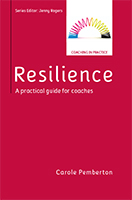You deal with changing job, changing employer, moving home and take it all in your stride. You manage the daily ups and downs of life which call on you to swiftly change plans and readjust. Then ‘Bang’ something happens which floors you. The person who could roll with the punches disappears. You find yourself struggling to keep things in perspective, to retain any sense of optimism and confidence goes through the floor. What’s happened? You have lost your resilience. You still turn up at work, but the person you bring is changed. The person who could see endless solutions, can see none. The person who loved a challenge, will only work within their comfort zone. The person who prided themselves on managing their emotion finds they have difficulty controlling them, or the only emotions available to them are negative. The loss of confidence is picked up by clients, or colleagues notice you bring less energy and engagement to the work you do. Resilience is more than an individual issue it is a business issue.
Resilience is that elasticity which enables people to both be stretched and to get back into shape. It is a quality that is tested when individuals lose their jobs. It is equally tested when the job remains but the demands on it increase, or those things which made the role satisfying are removed. There are many in UK plc whose resilience is being tested, and the people judged the most talented, may also be the ones who are feeling less than resilient. That is why it was a timely topic for the recent Association for Coaching Conference.
So if UK resilience is being diminished by the current climate, what can organisations do? Professor Anthony Grant of the Coaching Psychology Unit at Sidney University argued that resilience can be increased through a combination of training and coaching. In a randomised control study in an Australian Insurance company, he showed that training in resilience skills immediately followed by coaching led to significant increase in goal attainment, a reduction in depression and an increase in workplace wellbeing, whilst those offered training alone saw a worsening of all 3 dimensions in the weeks following training. This was reversed when later offered coaching. At a conference of coaches you would expect coaching to be part of the answer, but it is not the whole answer. Given that organisations will get more value from self confident, optimistic individuals who can manage their emotions and adapt to changes, there is a role for training in helping support the building of resilience.
In a field which is fast expanding, the work of consultancy Team Focus offered a model which captures key themes of resilience building. It works from the premise that when resilience is lost, the individual has become Frozen in a view of themselves. “I did not get that promotion, so my career is over”. Unfreezing it comes from enabling them to look at their view of self to examine how well it holds up to a reality check. “My career is not dependent on the outcome of one promotion decision”. With the loosening it becomes possible to Reformulate new possibilities. “If I look to develop through taking on that project I have been avoiding, my possibilities will widen”. From which a Reframing of a new and realistic self concept emerges, “I can see why that promotion was not right for me at this time, but I now know what I need to do to move forward”.
If losing resilience is about losing bounce refinding is not about bouncing back. To bounce back suggests nothing has changed. When resilience is knocked the learning is about being able to move forward with new insights. Or as Dr Chris Johnson author of The Power of Hope highlighted, resilience is the pearl in the oyster. Just as the pearl is formed from the oyster responding to the irritation of the grit, losing resilience has powerful lessons to teach from which an even more resourceful self can emerge.




